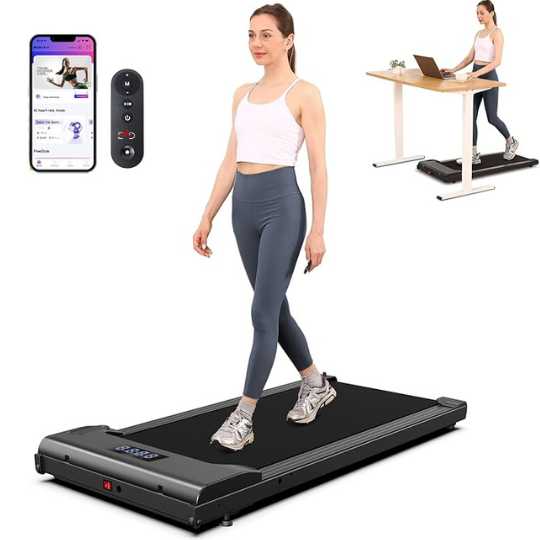Exercise Daily – Let’s be honest: dealing with a shaking washer or a noisy treadmill at home can be seriously annoying. Whether it’s your Walking Pad bouncing during a spin cycle or your new walking pad sliding across the floor while you’re trying to get your steps in, unwanted vibration and movement are a real buzzkill. But guess what? There’s a simple fix: vibration pads.
These clever little additions not only prevent your appliances from “walking” but also reduce noise, protect your floors, and keep everything where it should be. Ready to make your laundry room or home gym a whole lot quieter and safer?
Let’s dive into the 7 best walking vibration pads for home fitness and appliances in 2025.
Why Your Walking Pad Needs Vibration Pads
Appliances like Walking Pads aren’t exactly gentle. They vibrate, shift, and can even damage your flooring over time. A good anti-vibration pad absorbs shock, reduces movement, and dampens noise. Whether you’re dealing with an unbalanced washer or a treadmill that won’t sit still, vibration pads are your go-to solution.
What Makes a Great Vibration Pad?
Before we dive into the list, here’s what makes a pad worth your money:
-
Shock absorption: Handles heavy-duty movement during high-speed spins or workouts
-
Noise reduction: Minimizes rattling sounds
-
Non-slip grip: Stops appliances from walking around
-
Durability: Made with hard-wearing square rubber or anti-slip composite
-
Easy installation: Just lift and slide under
-
Universal fit: Works for most washer and dryer setups and walking pads
The 7 Best Walking Vibration Pads for 2025
1. Sperax Walking Vibration Pad with APP – 3-in-1 Under-Desk Treadmill
The latest 3-in-1 Sperax pad squeezes three workout modes (walking, jogging, and whole-body vibration) into a slab no thicker than a hardcover book. A 2.5 HP servo motor drives speeds from a gentle 0.2 mph stroll to a brisk 3.8 mph walk while supporting users up to 350 lb. At just 26 lb and 39 × 21 × 3.5 in, it slides under a sofa or desk when you’re done. The companion app and bundled remote change speed, toggle vibration levels, and log distance, time, and calories in real time. If you want a quiet, space-saving cardio option you can also stand on for recovery massage, this is the most compact route in Sperax’s line-up.

Key Features
-
2.5 HP servo motor, 0.2-3.8 mph speed range
-
Three modes: walk, jog, vibration massage
-
350 lb weight capacity on metal/ABS frame
-
LED display plus Bluetooth-APP/remote control
-
39 × 21 in running deck with non-slip surface
-
Weighs only 26 lb; built-in wheels for storage
Pros
-
Lightest unit here, easy to move or store
-
Vibration mode adds passive muscle activation
-
Quiet motor suits shared living or offices
-
High weight limit for its size
Cons
-
Top speed limited to fast walking
-
No incline option
-
Narrower belt than full treadmills
2. Sperax Walking Vibration Pad – 4-in-1 Multifunctional Pad
Sperax’s 4-in-1 variant builds on the design above and layers four independent programs: adjustable vibration training, walking, fat-burning jog, and app-guided routines, onto a widened symmetrical deck. The dual-sided hidden motors free up extra foot room and keep noise down; they still deliver a solid 2.5 HP and up to 3.8 mph. An LED console plus remote or phone app gives fingertip control, while the 350 lb rating suits most users. At 22 lb, it’s lighter than many laptops, making it a practical “pull-out-when-needed” fitness fix for cramped apartments.
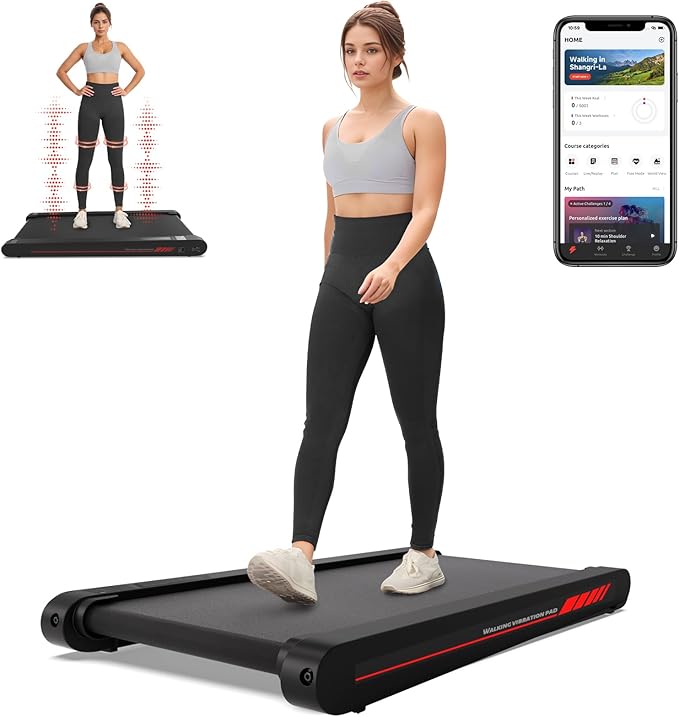
Key Features
-
Servo silent motor, 2.5 HP / 0.2-3.8 mph
-
Four modes: walk, jog, vibration (4 levels), fat-burn program
-
350 lb load rating; ABS shell with skid-proof top
-
Symmetrical motor layout yields a wider running belt
-
Remote + smartphone APP + LED read-out
-
19.5 × 21 × 3.5 in folded footprint; 27 lb weight
Pros
-
Widest deck among ultra-slim pads
-
Multiple vibration intensities for rehab or warm-up
-
Very light and zero assembly
-
Quiet enough for early-morning use
Cons
-
Still capped at walking speeds
-
No incline or handrail option
-
The app interface is basic compared with full treadmills
3. FUNRAY Versatile Walking Pad with 5 % Manual Incline
FUNRAY attacks monotony with a dual-sided deck: flip it over for pebble-textured foot-massage recovery, flip back for walking. A 2.5 HP motor, 0.6-4 mph range, and 330 lb capacity cover most office-hour cardio needs, while a manual 5 % incline lets you raise your heart rate without raising speed. The alloy-steel frame, multi-point shock absorbers, and 5-layer belt protect joints; at 43.5 × 21.5 × 5.1 in, it is taller than the Sperax pads but still slides under a couch. Modes for dog-walking and massage make it a family-friendly all-rounder.
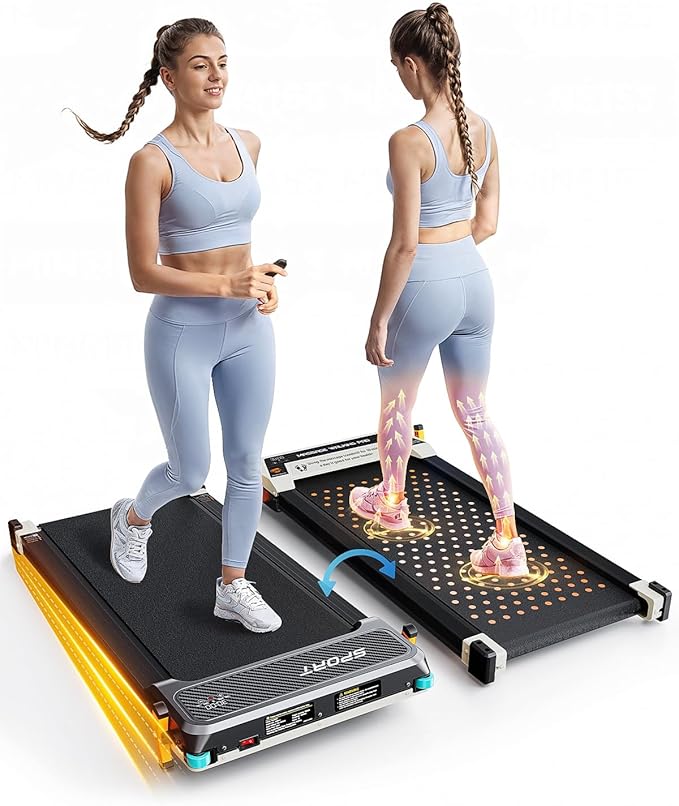
Key Features
-
2.5 HP motor, 0.6-4 mph, 330 lb capacity
-
Manual 5 % incline knob
-
Dual-sided deck: running surface / pebble-massage side
-
Walking, jogging, massage, and pet-running modes
-
Alloy-steel frame with full-length shock absorption
-
Ships with remote, lube kit, and power cord
Pros
-
Only pad here with built-in incline + foot massage
-
The highest user weight limit outside full treadmills
-
Multi-mode design suits varied household use
Cons
-
Taller (5 in), so it doesn’t fit under very low furniture
-
Manual, not electronic, incline adjustment
-
The massage surface collects dust if stored pebble-side up
4. THERUN 2.5 HP 2-in-1 Walking Pad with Fold-Down Handle
THERUN’s flagship pad bridges slow desk strolls and genuine running. Fold the handrail down and it slots under a standing desk at 0.6-3.8 mph; raise it and you unlock 0.6-6.2 mph sprint speeds; double most pads. The steel chassis supports 300 lb, while the 38 × 15 in five-layer belt is the broadest surface in this list, giving confident foot placement. A remote and on-rail LED touch screen shares control duties. At 43 lb, it’s heavier, but integrated wheels and a slim 6-in profile keep storage realistic.
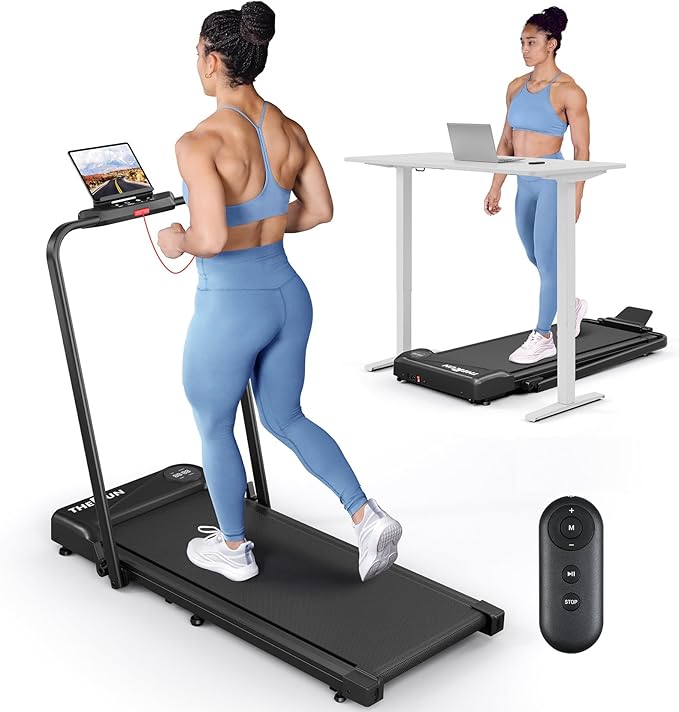
Key Features
-
2.5 HP quiet motor, 0.6-6.2 mph dual-mode
-
Fold-flat handrail converts pad to treadmill
-
300 lb weight capacity on alloy-steel frame
-
38 × 15 in cushioned belt, double-deck deck design
-
Remote + LED touch bar, no assembly required
-
Automatic standby power-saving mode
Pros
-
Fastest top speed on the list
-
The wide running area feels like a gym unit
-
Handle adds safety for seniors or intervals
Cons
-
Heaviest unit (≈ 43 lb)
-
6-in folded height may not fit under every sofa
-
Needs a dedicated power outlet (user-reported tripping)
5. AKLUER Walking Pad with Manual Incline
AKLUER’s pad offers a rare combo of incline and sub-4-inch profile. The alloy-steel frame houses a 2.5 HP motor (0.6-4.0 mph) and a quick-set incline wedge that bumps intensity without lengthening workouts. At 42.9 × 19.7 × 3.85 in and 33.5 lb, it balances deck size and portability, and it folds away beneath most beds. Bluetooth speakers stream workout playlists while the LED panel tracks time, speed, distance, and calories. Rated for 200-330 lb, depending on model, it is a solid mid-price option for walkers chasing an extra burn.
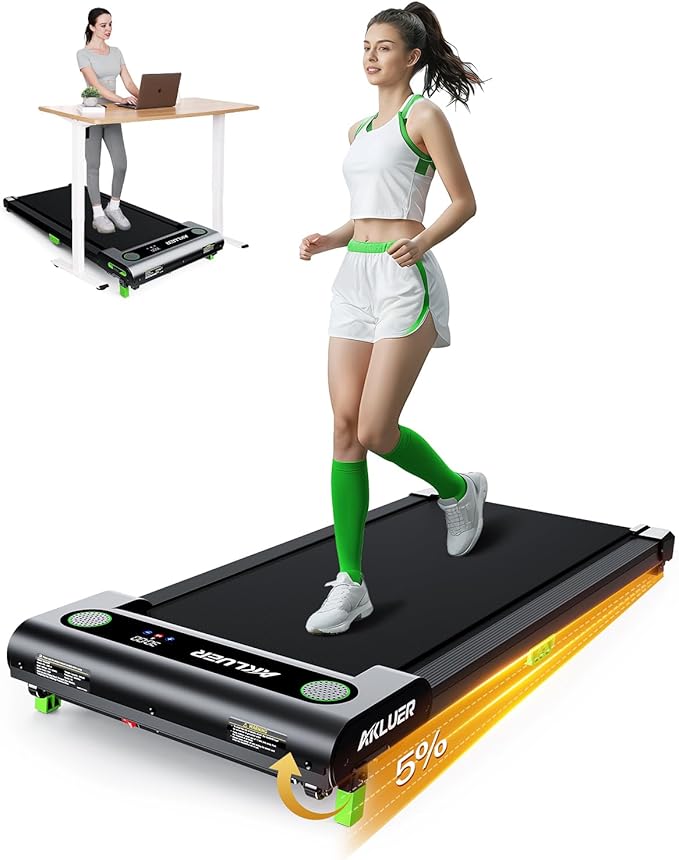
Key Features
-
2.5 HP motor, 0.6-4 mph speed band
-
Manual incline platform (≈ 4-6 %)
-
42.9 × 19.7 in deck, 33.5 lb net weight
-
Bluetooth audio + remote control
-
FCC/UL-certified electronics
-
Slides under 4-in clearance furniture
Pros
-
Slimmest incline-capable pad here
-
Built-in speakers for entertainment
-
Light enough to carry upstairs alone
Cons
-
Lower published weight limit on some variants (200 lb)
-
No app connectivity
-
Manual incline means pausing the workout to adjust
6. THERUN Portable Mini Walking Pad
Designed for tiny flats or dorm rooms, THERUN’s mini pad keeps bulk low (≈ 38 lb, 42 × 19.5 × 6.3 in) yet retains a 2.5 HP motor and 0.6-3.8 mph range. A 6 % fixed incline version exists, but even the basic model fits under most standing desks. Remote control, LED feedback, and wheels tick usability boxes; the 265-300 lb capacity (model-dependent) covers the average adult. With no handle or massage gimmicks, this is the minimalist’s pick for walk-while-you-work cardio.
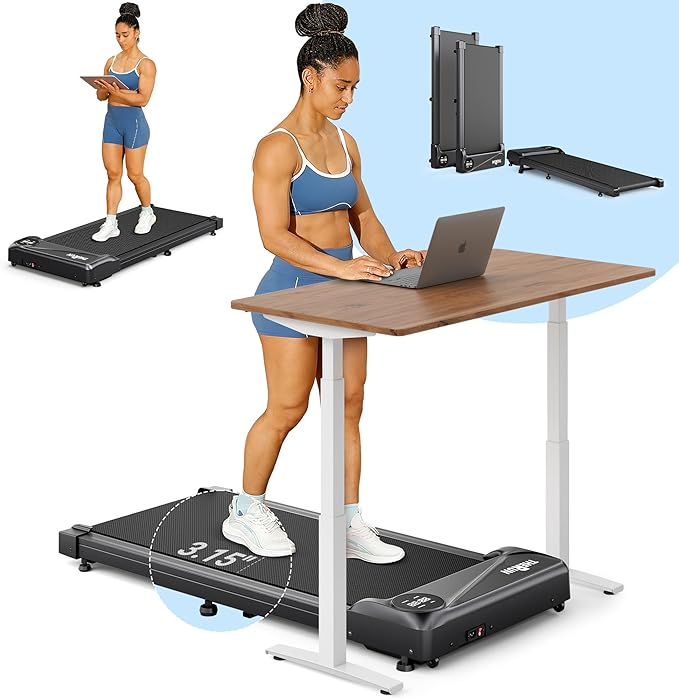
Key Features
-
2.5 HP motor, 0.6-3.8 mph
-
Optional 6 % manual incline model
-
42 × 19.5 in deck, 38 lb weight
-
Remote control + LED console
-
Zero assembly; wheels for easy slide-out storage
Pros
-
Compact yet still supports a jogging pace
-
Incline variant for extra calorie burn
-
Simple plug-and-play setup
Cons
-
No onboard app or Bluetooth
-
Narrow belt for running strides
-
Taller folded height (6 in) than ultra-slims
7. Lichico 2.5 HP Brushless Walking Pad
Lichico swaps the usual brushed DC motor for a durable brushless unit, cutting noise and heat; ideal if you share a workspace. The deck measures 47.2 × 20 in and tops out at 4 mph, driven by a 2.5 HP motor and twin shock-absorption layers (floating deck + TPR pad) to spare knees on long conference calls. At 37.5 lb, it rolls away on front casters and lies just 4 in tall. A simple remote governs speed; the charcoal finish blends into office décor when idle.

Key Features
-
2.5 HP brushless motor (whisper-quiet)
-
0.6-4 mph speed range, 47.2 × 20 in deck
-
Dual shock-absorption system
-
37.5 lb weight; 4 in high for under-sofa storage
-
Remote control + LED stats panel
-
Space-saving front wheels for repositioning
Pros
-
Quietest model thanks to brushless drive
-
Longest deck among slim pads; good for taller users
-
Low 4-in profile fits tight spaces
Cons
-
No incline or running speeds
-
Remote only; no app or handrail
-
Finish shows scuffs more readily than lighter colours
How to Install Vibration Pads Under a Washer or Walking Pad
Installing vibration pads under your Walking Pad or walking pad might sound like a complicated task, but trust me, it’s not. This is one of the easiest home upgrades you can do that makes a huge difference. No need to grab a toolbox or call a professional. With just a little patience (and maybe a second set of hands if you’re dealing with a heavier appliance), you’ll have your machine secured and stabilized in no time.
Step-by-Step Installation Guide
Let’s break it down:
1. Clear the Area
Before you begin, clear the surrounding area. Remove baskets, cleaning supplies, or anything that could get in your way. You’ll want full access to all four feet of the machine.
If it’s a walking pad (the kind used for treadmill walking indoors), simply unplug and move it slightly to prepare.
2. Clean the Floor
Next, sweep or vacuum underneath the machine. Dust, hair, or even tiny pebbles can affect how well the vibration pad grips the floor. A clean, dry surface is essential for that non-slip connection.
3. Tilt the Machine Gently
Here’s where a little muscle helps. If your machine isn’t too heavy, you can tilt it yourself. But with large washer and dryer units, it’s smart to have someone help you out. You don’t need to lift the entire unit, just raise one side enough to slide the anti-vibration pad underneath.
For a walking pad treadmill, it’s usually lightweight enough to lift one end easily.
4. Place One Pad Under Each Foot
Most pads for Walking Pads come in a set of four. Place one directly under each leg or wheel of the machine. Make sure it’s centered; this helps evenly distribute the load and minimizes any rocking.
5. Set the Machine Down Carefully
Once the pads are positioned, gently lower the machine back down. Give it a little shake (gently!) to make sure it’s stable and not wobbling. If one pad feels off, you might need to reposition it.
6. Done in Under 5 Minutes
That’s it. No screws, bolts, or glue. Just a simple, quick fix that adds a ton of value. You’ll notice an immediate reduction in both noise and vibration, especially during spin cycles or when using a treadmill.
Choosing Between Mat vs. Rubber Pads
When shopping for vibration control, you’ll come across two main options: individual rubber pads or a large anti-slip mat. While both serve the same general purpose, to keep your machines from shaking, walking, or making a racket, they work a little differently. Let’s compare.
Rubber Pads – Precision and Portability
Rubber anti-vibration pads are the go-to for most homeowners. They’re small, usually square or circular, and made of dense, shock-absorbing material.
Why choose rubber pads?
-
Individual support: Each leg gets its own cushion, perfect for uneven floors.
-
Better for tight spaces: Especially under stacked washer/dryer units.
-
Easy to replace: If one pad wears out, you don’t have to replace the whole set.
-
Great for walkers/treadmills: Fits perfectly under exercise equipment.
These are ideal if you’re only using them for a single appliance, or if you need something more compact.
Anti-Slip Mats – Coverage and Convenience
A vibration mat is basically a wide, thick rubber mat that you roll out and place your appliances on top of.
Why choose a mat?
-
Covers both washer and dryer together, no guesswork.
-
Extra protection for floors, especially hardwood or tile.
-
Simple layout, just place and go.
-
Works for awkward machines that have unusual feet spacing.
If you’ve got multiple machines side-by-side or just want a “set it and forget it” option, go with the mat.
What Floor Types Work Best with These Pads?
One of the best things about anti-vibration pads is how versatile they are. Whether your laundry room has tiles, hardwood, or even a bare concrete slab, these pads work on virtually any surface. Here’s a quick look at how they perform on different floors:
Tile Flooring
Tile is slippery and unforgiving, especially when wet. Rubber pads grip tile well, preventing slippage and protecting the brittle surface from heavy appliance feet.
Laminate Flooring
Laminate looks nice, but it can scratch or dent easily. Pads help absorb impact and keep your washer from “walking” across the room.
Concrete Floors
Concrete can handle a lot, but it doesn’t absorb sound or vibration. Pads serve as a shock buffer between your machine and the hard floor, reducing noise and wear on the appliance.
Hardwood Flooring
Wood is beautiful but fragile when it comes to heavy, vibrating machines. Pads act as a barrier, preserving your floor’s finish while keeping the machine in place.
Pro Tip:
Always clean and dry the surface before placing pads. Even a little dust or moisture can weaken the pad’s anti-slip grip.
How to Know When It’s Time to Replace Your Vibration Pads
Just like anything else, vibration pads don’t last forever. Over time, the constant pressure, weight, and movement can wear them down. Here’s how to tell when it’s time for a fresh set:
1. Visible Cracks or Deformation
If you notice splits, dents, or uneven warping in the rubber, it’s a sign the pad is past its prime. Damaged pads can lead to instability or even damage to your appliance.
2. Loss of Grip
You might find your washer or dryer slowly shifting back into old habits, walking across the room or shaking during the spin cycle. If it’s moving again, your pads might have lost their non-slip edge.
3. Uneven Wear
Sometimes one pad wears out faster than the others, especially if your floor is uneven. This can cause the whole appliance to tilt slightly, putting stress on the drum or motor. Not good.
4. Reduced Noise Damping
If your machine has started sounding louder again, especially during high-speed cycles, your pads might not be absorbing vibration as well as they used to.
5. They Just Look Tired
If they’re stained, brittle, or have flattened out entirely, it’s time. Trust your gut.
Tip for Longevity:
Rotate your machine or re-check the pads every few months. A quick inspection can save you a headache later.
Final Thoughts
If your appliances shake, rattle, or roll, vibration pads are the secret weapon you didn’t know you needed. Whether you’re tired of your Walking Pad waking up the house or your walking pad dancing across the room, these simple rubber feet can transform your setup. They’re affordable, easy to install, and make a real difference.
So stop chasing your machines around the house. Lock them down, tone down the noise, and reclaim your peace and quiet.
FAQs – 7 Best Walking Vibration Pads for Home Fitness in 2025
Q: Will vibration pads work with front-load washers?
A: Yes. Most pads are universal and work well with both front-load and top-load machines.
Q: Can I use the same pads for both a washer and a treadmill?
A: Absolutely. Just make sure the pads you choose can handle the weight and vibration level.
Q: Do anti-vibration pads damage floors?
A: Nope. They’re made to protect your floors, especially delicate ones like wood or tile.
Q: How long do these pads typically last?
A: With normal use, expect 3–5 years. Some higher-quality ones last even longer.
Q: Are there any installation tools required?
A: Not at all. Just lift and slide, no screws, no drills, no stress.

